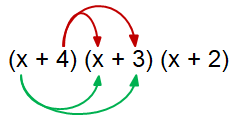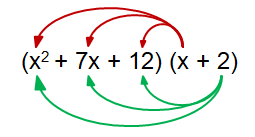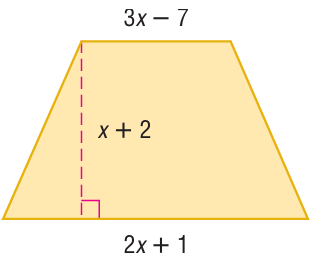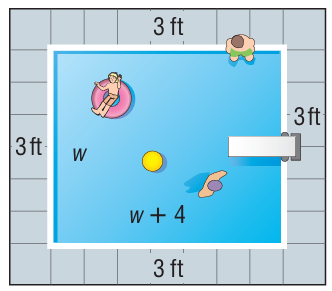MULTIPLYING BINOMIALS BY ONE ANOTHER
Expand and simplify :
Example 1 :
(x + 4) (x + 3) (x + 2)
Solution :
By expanding first two factors, we get

= [(x ∙ x) + (x ∙ 3) + (4 ∙ x) + (4 ∙ 3)] (x + 2)
= (x2 + 3x + 4x + 12)(x + 2)
By combining like terms,
= (x2 + 7x + 12) (x + 2)
By distributing x and 2, we get

= (x2 ∙ x) + (7x ∙ x) + (12 ∙ x) + (x2 ∙ 2) + (7x ∙ 2) + (12 ∙ 2)
= x3 + 7x2 + 12x + 2x2 + 14x + 24
By combining like terms,
= x3 + 2x2 + 7x2 + 12x + 14x + 24
= x3 + 9x2 + 26x + 24
Example 2 :
(x - 3)(x - 2)(x + 4)
Solution :
By expanding first two factors, we get
= [(x ∙ x) - (x ∙ 2) - (3 ∙ x) + (3 ∙ 2)] (x + 4)
= (x2 - 2x - 3x + 6)(x + 4)
= (x2 - 5x + 6)(x + 4)
By distributing x and 4, we get
= (x2 ∙ x) + (-5x ∙ x) + (6 ∙ x) + (x2 ∙ 4) + (-5x ∙ 4) + (6 ∙ 4)
= x3 - 5x2 + 6x + 4x2 - 20x + 24
By combining like terms,
= x3 - 5x2 + 4x2 + 6x - 20x + 24
= x3 - x2 - 14x + 24
Example 3 :
(x - 3)(x - 2)(x - 5)
Solution :
By expanding first two factors, we get
= [(x ∙ x) - (x ∙ 2) - (3 ∙ x) + (3 ∙ 2)] (x - 5)
= (x2 - 2x - 3x + 6) (x - 5)
= (x2 - 5x + 6)(x - 5)
By distributing x and 2, we get
= (x2 ∙ x) - (5x ∙ x) + (6 ∙ x) - (x2 ∙ 5) + (5x ∙ 5) - (6 ∙ 5)
= x3 - 5x2 + 6x - 5x2 + 25x - 30
By combining like terms,
= x3 - 5x2 - 5x2 + 6x + 25x - 30
= x3 - 10x2 + 31x - 30
Example 4 :
(2x - 3)(x + 3)(x - 1)
Solution :
By expanding first two factors, we get
= [2x(x) + 2x(3) - 3(x) - 3(3)] (x - 1)
= (2x2 + 6x - 3x - 9) (x - 1)
= (2x2 + 3x - 9) (x - 1)
= 2x2(x) - 2x2(1) + 3x(x) - 3x(1) - 9(x) + 9
= 2x3 - 2x2 + 3x2 - 3x - 9x + 9
= 2x3 + x2 - 12x + 9
Example 5 :
(3x + 5)(x + 1)(x + 2)
Solution :
By expanding first two factors, we get
= [3x(x) + 3x(1) + 5(x) + 5(1)] (x + 2)
= (3x2 + 3x + 5x + 5) (x + 2)
= (3x2 + 8x + 5) (x + 2)
= 3x2(x) + 3x2(2) + 8x(x) + 8x(2) + 5(x) + 5(2)
= 3x3 + 6x2 + 8x2 + 16x + 5x + 10
= 3x3 + 14x2 + 21x + 10
Example 6 :
(4x + 1)(3x - 1)(x + 1)
Solution :
By expanding first two factors, we get
= [4x(3x) - 4x(1) + 1(3x) - 1(1)] (x + 1)
= (12x2 - 4x + 3x - 1) (x + 1)
= (12x2 - x - 1) (x + 1)
= 12x2(x) + 12x2(1) - x(x) - x(1) - 1(x) - 1(1)
= 12x3 + 12x2 - x2 - x - x - 1
= 12x3 + 11x2 - 2x - 1
Example 7 :
(2 - x)(3x + 1)(x - 7)
Solution :
By expanding first two factors, we get
= [2(3x) + 2(1) - x(3x) - x(1)] (x - 7)
= (6x + 2 - 3x2 - x) (x - 7)
= (-3x2 + 5x + 2) (x - 7)
= -3x2(x) + 3x2(7) + 5x(x) - 5x(7) + 2(x) - 2(7)
= -3x3 + 21x2 + 5x2 - 35x + 2x - 14
= -3x3 + 26x2 - 33x - 14
Example 8 :
(x - 2)(4 - x)(3x + 2)
Solution :
By expanding first two factors, we get
= [x(4) - x(x) - 2(4) + 2(x)] (3x + 2)
= (4x - x2 - 8 + 2x) (3x + 2)
= (-x2 + 6x - 8) (3x + 2)
= -x2(3x) - x2(2) + 6x(3x) + 6x(2) - 8(3x) - 8(2)
= -3x3 - 2x2 + 18x2 + 12x - 24x - 16
= -3x3 + 16x2 - 12x - 16
Example 9 :
The area A of a trapezoid is one half the height h times the sum of the bases b1 and b2. Write the expression for the area of the trapezoid.

Solution :
Area of trapezoid = (1/2) ⋅ h(a + b)
Height = x + 2, a = 2x + 1 and b = 3x - 7
= (1/2) ⋅ (x + 2) (2x + 1 + 3x - 7)
= (1/2) ⋅ (x + 2) (5x - 6)
= (1/2) ⋅ (5x2 - 6x + 10x - 12)
= (1/2) ⋅ (5x2 + 4x - 12)
So, area of the trapezoid is (1/2) ⋅ (5x2 + 4x - 12) square units.
Example 10 :
A homeowner is installing a swimming pool in his backyard. He wants its length to be 4 feet longer than its width. Then he wants to surround it with a concrete walkway 3 feet wide. If he can only afford 300 square feet of concrete for the walkway, what should the dimensions of the pool be ?

Solution :
Length of backyard = w + 4 + 3 + 3
= (w + 10) ft
Width of backyard = w + 3 + 3
= (w + 6) ft
Length of pool = w + 4
Width of pool = w
Area of concrete = Area of backyard - area of pool
= (w + 10)(w + 6) - w(w + 4)
= w2 + 6w + 10w + 60 - w2 - 4w
= 6w + 10w - 4w + 60
300 = 12w + 60
300 - 60 = 12w
w = 240 / 12
w = 20
Length of pool = 20 + 4 ==> 24 ft
Width of pool = 20 ft
Recent Articles
-
Finding Range of Values Inequality Problems
May 21, 24 08:51 PM
Finding Range of Values Inequality Problems -
Solving Two Step Inequality Word Problems
May 21, 24 08:51 AM
Solving Two Step Inequality Word Problems -
Exponential Function Context and Data Modeling
May 20, 24 10:45 PM
Exponential Function Context and Data Modeling